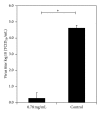In Vitro Virucidal and Virustatic Properties of the Crude Extract of Cynodon dactylon against Porcine Reproductive and Respiratory Syndrome Virus
- PMID: 24744959
- PMCID: PMC3972871
- DOI: 10.1155/2014/947589
In Vitro Virucidal and Virustatic Properties of the Crude Extract of Cynodon dactylon against Porcine Reproductive and Respiratory Syndrome Virus
Abstract
The in vitro virustatic and virucidal tests of the crude extract of Cynodon dactylon against infection with porcine reproductive and respiratory syndrome virus (PRRSV), a cause of major devastating pig disease, were described. Crude extract of C. dactylon was prepared for cytotoxicity on tissue-culture cells that were used to measure virustatic and virucidal activities against PRRSV. Crude extract of C. dactylon at 0.78 mg/mL showed no cytotoxicity on the cell line, and at that concentration significantly inhibited replication of PRRSV as early as 24 hours post infection (hpi). C. dactylon also inactivated PRRSV as determined by immunoperoxidase monolayer assay (IPMA) compared to the control experiments. In summary, the present study may be among the earliest studies to describe virustatic and virucidal activities of C. dactylon crude extract against PRRSV in vitro. Extracts of C. dactylon may be useful for PRRSV control and prevention on pig farms.
Figures


Similar articles
-
Effect of Ethanolic Caesalpinia sappan Fraction on In Vitro Antiviral Activity against Porcine Reproductive and Respiratory Syndrome Virus.Vet Sci. 2021 Jun 9;8(6):106. doi: 10.3390/vetsci8060106. Vet Sci. 2021. PMID: 34207801 Free PMC article.
-
In vitro screening antiviral activity of Thai medicinal plants against porcine reproductive and respiratory syndrome virus.BMC Vet Res. 2020 Mar 30;16(1):102. doi: 10.1186/s12917-020-02320-8. BMC Vet Res. 2020. PMID: 32228582 Free PMC article.
-
In vitro evaluation of antiviral activity of tea seed saponins against porcine reproductive and respiratory syndrome virus.Antivir Ther. 2015;20(7):743-52. doi: 10.3851/IMP2937. Epub 2015 Jan 22. Antivir Ther. 2015. PMID: 25609356
-
Mosquitocidal and water purification properties of Cynodon dactylon, Aloe vera, Hemidesmus indicus and Coleus amboinicus leaf extracts against the mosquito vectors.Parasitol Res. 2012 Apr;110(4):1435-43. doi: 10.1007/s00436-011-2646-3. Epub 2011 Sep 23. Parasitol Res. 2012. PMID: 21947308
-
Inactivated and subunit vaccines against porcine reproductive and respiratory syndrome: Current status and future direction.Vaccine. 2015 Jun 17;33(27):3065-72. doi: 10.1016/j.vaccine.2015.04.102. Epub 2015 May 14. Vaccine. 2015. PMID: 25980425 Review.
Cited by
-
Effect of Ethanolic Caesalpinia sappan Fraction on In Vitro Antiviral Activity against Porcine Reproductive and Respiratory Syndrome Virus.Vet Sci. 2021 Jun 9;8(6):106. doi: 10.3390/vetsci8060106. Vet Sci. 2021. PMID: 34207801 Free PMC article.
-
Indian Medicinal Plants and Formulations and Their Potential Against COVID-19-Preclinical and Clinical Research.Front Pharmacol. 2021 Mar 2;11:578970. doi: 10.3389/fphar.2020.578970. eCollection 2020. Front Pharmacol. 2021. PMID: 33737875 Free PMC article. Review.
-
Evaluation of the Inhibitory Effects of (E)-1-(2-hydroxy-4,6-dimethoxyphenyl)-3-(naphthalen-1-yl)prop-2-en-1-one (DiNap), a Natural Product Analog, on the Replication of Type 2 PRRSV In Vitro and In Vivo.Molecules. 2019 Mar 3;24(5):887. doi: 10.3390/molecules24050887. Molecules. 2019. PMID: 30832429 Free PMC article.
-
In vitro screening antiviral activity of Thai medicinal plants against porcine reproductive and respiratory syndrome virus.BMC Vet Res. 2020 Mar 30;16(1):102. doi: 10.1186/s12917-020-02320-8. BMC Vet Res. 2020. PMID: 32228582 Free PMC article.
-
Attempt to Isolate Elephant Endotheliotropic Herpesvirus (EEHV) Using a Continuous Cell Culture System.Animals (Basel). 2020 Dec 7;10(12):2328. doi: 10.3390/ani10122328. Animals (Basel). 2020. PMID: 33297581 Free PMC article.
References
-
- Shi M, Lam TT-Y, Hon C-C, et al. Molecular epidemiology of PRRSV: a phylogenetic perspective. Virus Research. 2010;154(1-2):7–17. - PubMed
-
- Albina E. Epidemiology of porcine reproductive and respiratory syndrome (PRRS): an overview. Veterinary Microbiology. 1997;55(1–4):309–316. - PubMed
-
- Chand RJ, Trible BR, Rowland RR. Pathogenesis of porcine reproductive and respiratory syndrome virus. Current Opinion in Virology. 2012;2(3):256–263. - PubMed
-
- Thanawongnuwech R, Thacker EL, Halbur PG. Influence of pig age on virus titer and bactericidal activity of porcine reproductive and respiratory syndrome virus (PRRSV)-infected pulmonary intravascular macrophages (PIMs) Veterinary Microbiology. 1998;63(2–4):177–187. - PubMed
-
- Cho JG, Dee SA, Deen J, et al. Evaluation of the effects of animal age, concurrent bacterial infection, and pathogenicity of porcine reproductive and respiratory syndrome virus on virus concentration in pigs. American Journal of Veterinary Research. 2006;67(3):489–493. - PubMed
LinkOut - more resources
Full Text Sources
Other Literature Sources

